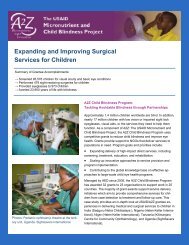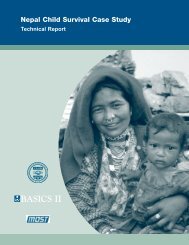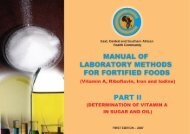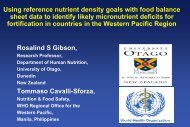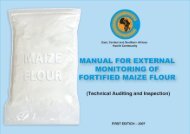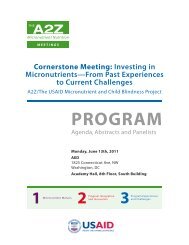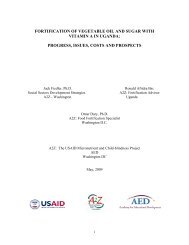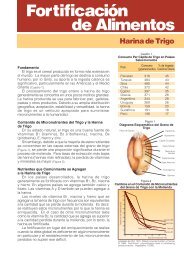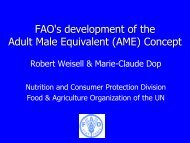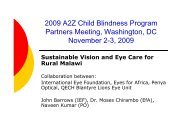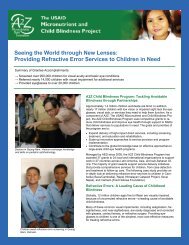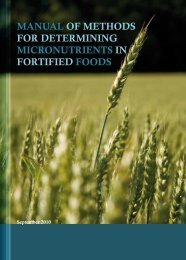Vitamin A Global Initiative - A2Z: The USAID Micronutrient and Child ...
Vitamin A Global Initiative - A2Z: The USAID Micronutrient and Child ...
Vitamin A Global Initiative - A2Z: The USAID Micronutrient and Child ...
Create successful ePaper yourself
Turn your PDF publications into a flip-book with our unique Google optimized e-Paper software.
GLOBAL INITIATIVE<br />
About vitamin A deficiency<br />
Every year, 11.3 million children under 5 years old die in the developing<br />
world, over six million of them directly or indirectly from malnutrition.<br />
Millions more children are malnourished. Less strong <strong>and</strong> less<br />
healthy than they should be, they have fewer opportunities to reach<br />
their full potential in life.<br />
<strong>The</strong> problem of vitamin A deficiency (VAD) is global. It affects more<br />
than 100 million children <strong>and</strong> is responsible for as many as one out<br />
of every four child deaths in regions, countries <strong>and</strong> communities<br />
where the problem exists. Now, there is also more <strong>and</strong> more evidence<br />
that VAD increases the risk of maternal death.<br />
<strong>Vitamin</strong> A is essential for the functioning of the immune system.<br />
Giving vitamin A supplements to children who need them increases<br />
their resistance to disease, <strong>and</strong> improves their chances for survival,<br />
growth <strong>and</strong> development.<br />
Safety of vitamin A<br />
supplements<br />
Concerns have been<br />
expressed in many countries<br />
about the dangers of toxicity<br />
of high-dose vitamin A supplementation.<br />
But the benefits<br />
of vitamin A supplementation<br />
far outweigh any side<br />
effects, which are transient<br />
<strong>and</strong> very rare.<br />
Most vitamin A supplementation<br />
programmes use highdose<br />
capsules. <strong>The</strong>se doses<br />
are completely safe for children<br />
when given at least a<br />
month apart. Safe lower<br />
doses have been established<br />
for pregnant women.<br />
In the past, VAD has been seen<br />
merely as a cause of blindness,<br />
<strong>and</strong> in many countries vitamin<br />
A activities are still limited to<br />
blindness prevention programmes.<br />
In other countries, no<br />
action has been taken <strong>and</strong> no<br />
assessment of the problem<br />
exists. About 30 countries will<br />
achieve the Year 2000 goal of<br />
elimination of VAD. Many more<br />
will not.<br />
It is now clear that elimination<br />
of VAD as a public health problem<br />
must be a principal element<br />
of child survival <strong>and</strong><br />
maternal survival programmes<br />
where the problem exists.<br />
Eliminating VAD as a public<br />
health problem is a challenge the<br />
world must take on today.<br />
REASONS FOR ACTION<br />
Improving vitamin A status of<br />
deficient children increases their<br />
chances of survival:<br />
■ Death from measles can be<br />
reduced by 50 per cent<br />
■ Death from diarrhoea can be<br />
reduced by 40 per cent<br />
■ Overall mortality can be<br />
reduced by 25 per cent<br />
Improving vitamin A status of<br />
children reduces the severity of<br />
childhood illnesses:<br />
■ Less strain on clinic <strong>and</strong> outpatient<br />
services<br />
■ Fewer hospital admissions<br />
■ Contributes to the well-being of<br />
children <strong>and</strong> families<br />
Improving vitamin A status also:<br />
■ Prevents night blindness,<br />
xerophthalmia, corneal destruction<br />
<strong>and</strong> blindness<br />
■ May reduce birth defects<br />
■ May prevent epithelial <strong>and</strong> perhaps<br />
other types of cancer<br />
Improving vitamin A status may<br />
reduce maternal mortality:<br />
■ Improves resistance to infection<br />
■ Helps reduce anemia<br />
Improving vitamin A status is<br />
very cost-effective:<br />
■ Just a few cents per capsule<br />
■ Reduces health costs by lessening<br />
hospital <strong>and</strong> clinic visits<br />
■ Easily integrated into existing<br />
public health/immunization<br />
programmes
Action need not wait for assessment<br />
Many countries or regions may not realize that VAD is a problem,<br />
since they do not have up-to-date national-level assessments of the<br />
prevalence of VAD.<br />
National-level assessments should take place as soon as possible in all<br />
countries that do not have such assessments. But action to eliminate<br />
VAD should not wait for the results of these surveys.<br />
Some countries have carried out assessments using ocular indicators,<br />
such as Bitot’s spots. However, these ocular signs are associated with<br />
advanced stages of VAD. Women <strong>and</strong> children may be at needlessly<br />
high risk of dying long before any eye problems are evident.<br />
A high infant-mortality or under-five mortality rate (U5MR>70)<br />
should be taken as an indicator of a likely VAD problem, especially<br />
if it is also known that overall child malnutrition <strong>and</strong> low<br />
birthweights are prevalent <strong>and</strong> consumption of vitamin A-rich<br />
foods is low.<br />
Governments in countries with high infant or child mortality<br />
should work with partners to put in place a programme for control<br />
of VAD, including assessment of the problem, as part of a<br />
comprehensive strategy to reduce child mortality.<br />
PROGRAMME ACTIVITIES<br />
<strong>The</strong>re are a number of ways to improve<br />
the vitamin A status of populations.<br />
<strong>Vitamin</strong> A-rich foods are not always<br />
readily accessible to people who need<br />
them. In many parts of the industrialized<br />
world, food products are fortified<br />
to ensure that populations receive adequate<br />
amounts of the vitamin. In many<br />
countries, children <strong>and</strong> adults alike<br />
take daily vitamin supplements. <strong>The</strong><br />
following are the fastest <strong>and</strong> most<br />
cost-effective approaches to improving<br />
vitamin A status of populations.<br />
<strong>Vitamin</strong> A supplements can end VAD<br />
as a public health problem.<br />
Supplementation is:<br />
■ cost-effective<br />
■ safe<br />
■ sustainable<br />
■ easily implemented on a national scale<br />
■ can be carried out for many years<br />
Supplementation using vitamin A capsules<br />
should begin at six months old in<br />
areas where children do not get<br />
enough vitamin A in their diets.<br />
Mortality reduction potential is very<br />
high, <strong>and</strong> the benefits of high-dose<br />
supplements far outweigh the very rare<br />
<strong>and</strong> transient side effects. Capsules<br />
cost just a few cents each <strong>and</strong> can be<br />
distributed through exp<strong>and</strong>ed programmes<br />
on immunization, National<br />
Immunization Days or other public<br />
health contacts.<br />
Breastfeeding support is key to reducing<br />
VAD among young children. New<br />
mothers should receive a high-dose vitamin<br />
A supplement within 8 weeks of<br />
delivery in areas where deficiency exists.<br />
In some countries, where industrial <strong>and</strong><br />
commercial infrastructure is adequate,<br />
fortification of food staples like flour,<br />
sugar <strong>and</strong> margarine can help end VAD.<br />
Fortification can be very cost-effective.<br />
Dietary improvement, including ensuring<br />
regular access to foods that are naturally<br />
rich in vitamin A, will be part of a<br />
long-term-strategy in many countries.



